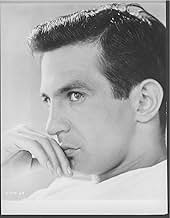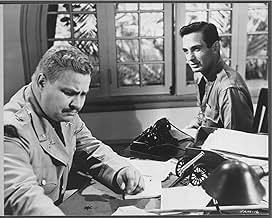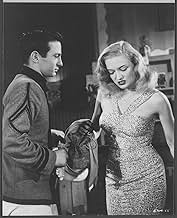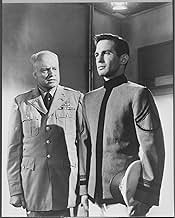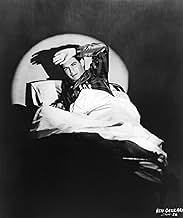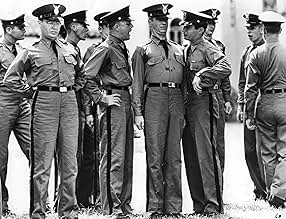ÉVALUATION IMDb
6,9/10
1,4 k
MA NOTE
Des étudiants sont confrontés à un dilemme éthique sur la déshumanisation associée à la tradition du bizutage, dans un collège militaire du sud des États-Unis.Des étudiants sont confrontés à un dilemme éthique sur la déshumanisation associée à la tradition du bizutage, dans un collège militaire du sud des États-Unis.Des étudiants sont confrontés à un dilemme éthique sur la déshumanisation associée à la tradition du bizutage, dans un collège militaire du sud des États-Unis.
Peter Mark Richman
- Cadet Colonel Corger
- (as Mark Richman)
Vergel Cook
- Jo
- (uncredited)
Avis en vedette
An upper class man at a rigid southern military academy abuses his power in a highly conceived plot in order to orchestrate an expulsion of another cadet. We're left to wonder why he's motivated to do so, and the acting and scenes in this part of the film do seem to be too staged, but the film makes for riveting viewing as in its portrayal of the overall ambiance of the the academy, a strange hierarchy with bizarre scenes of interaction between the lower and upper class men. And a final military brand of cadet justice that unites the two classes gets born out of the incident, and reveals a lot, and ends in a chilling finale with superior night scenes.
Back in the 1950s the movie Production Code in the U.S. censored topics and dialogue that it considered morally offensive or too provocative for a general audience. To get around this, Hollywood disguised the plot and dialogue in some films. The disguise allowed the presentation of underlying subversive themes, but in veiled form. "The Strange One" is a film with a provocative premise rendered opaque by its plot and dialogue.
A Machiavellian-minded Cadet named Jocko DeParis (Ben Gazzara) throws his weight around at a Southern military academy. DeParis is a terrible human being: bullying, manipulative, and sadistic, yet unemotional, always in control of the situation. In the film's plot, he carries through on a well-thought-out scheme to have a cadet he doesn't like expelled. He uses other cadets to implement his plan, so that he personally cannot be blamed. One of his puppet cadets is a visually unappealing Cadet Simmons (Arthur Storch), a guy with a mouth full of conspicuous teeth, who doesn't approve of alcohol and doesn't like women.
Another Cadet in Jocko's orbit is Perrin, (a.k.a Cockroach), a slightly effeminate guy, played by Paul Richards. Cockroach hero-worships Jocko, which thus allows Jocko to humiliate him in front of others. Yet, Cockroach, who refers to Jocko as "Night Boy", has his own plans, disguised by the script's dialogue, when he tells Jocko: "All I want to have is your confidence and your friendship". Well, you can see where this is headed in one sense, though the plot implies something else. The dialogue is heavy on subtext. And the film was quite subversive in its day.
The film's B&W visuals are rather dark, in keeping with the story's subversive theme. A jazzy score amplifies the seedy nature of these inter-relationships. The film's casting and acting are quite good, Arthur Storch's bizarre performance notwithstanding.
On the negative side, the plot doesn't explain why Jocko had such a grudge against others at the academy, nor do we learn the basis for his apparent political hold on the academy's higher-ups.
Yet these are fairly minor issues. And my overall impression of "The Strange One" is highly favorable. In addition to a deeply thematic story, we get to see a number of actors early in their careers, including Gazzara, Pat Hingle, James Olson, and George Peppard, among others. This is a film that would have been all but forgotten had it not been released recently on DVD. It's worth a look.
A Machiavellian-minded Cadet named Jocko DeParis (Ben Gazzara) throws his weight around at a Southern military academy. DeParis is a terrible human being: bullying, manipulative, and sadistic, yet unemotional, always in control of the situation. In the film's plot, he carries through on a well-thought-out scheme to have a cadet he doesn't like expelled. He uses other cadets to implement his plan, so that he personally cannot be blamed. One of his puppet cadets is a visually unappealing Cadet Simmons (Arthur Storch), a guy with a mouth full of conspicuous teeth, who doesn't approve of alcohol and doesn't like women.
Another Cadet in Jocko's orbit is Perrin, (a.k.a Cockroach), a slightly effeminate guy, played by Paul Richards. Cockroach hero-worships Jocko, which thus allows Jocko to humiliate him in front of others. Yet, Cockroach, who refers to Jocko as "Night Boy", has his own plans, disguised by the script's dialogue, when he tells Jocko: "All I want to have is your confidence and your friendship". Well, you can see where this is headed in one sense, though the plot implies something else. The dialogue is heavy on subtext. And the film was quite subversive in its day.
The film's B&W visuals are rather dark, in keeping with the story's subversive theme. A jazzy score amplifies the seedy nature of these inter-relationships. The film's casting and acting are quite good, Arthur Storch's bizarre performance notwithstanding.
On the negative side, the plot doesn't explain why Jocko had such a grudge against others at the academy, nor do we learn the basis for his apparent political hold on the academy's higher-ups.
Yet these are fairly minor issues. And my overall impression of "The Strange One" is highly favorable. In addition to a deeply thematic story, we get to see a number of actors early in their careers, including Gazzara, Pat Hingle, James Olson, and George Peppard, among others. This is a film that would have been all but forgotten had it not been released recently on DVD. It's worth a look.
Calder Willingham started a career in Hollywood by writing the book, the Broadway play it was based on and finally the screenplay for his work End As A Man. Now on the screen with the title The Strange One it presents a really nasty picture of a southern military academy and some of the cadets there.
There's more than one strange individual in The Strange One. But the title refers to protagonist Ben Gazzara who is both charismatic and evil. A good old southern boy he holds the rest of his set in some kind of sway and they're all afraid of him.
What Gazzara has put in motion is a carefully laid out scheme to embarrass Larry Gates the second in command of the academy by getting his son Geoffrey Horne expelled. With the aid of some lower classmen and a couple of sycophants he gets Horne drunk and leaves him out all night on the parade grounds. Horne is expelled and later Gates loses control when confronting Gazzara.
But at some points all the worms turn. I suspect in both the novel and the play Gazzara gets worse than what he got here.
The play ran 105 performances on Broadway during the 1953-54 season and besides Gazzara, Pat Hingle, Paul Richards, Arthur Storch, and Peter Mark Richman all repeat their roles from Broadway.
Richards is a halfway out of the closet gay man who Gazzara just toys with, catch that deliciously erotic scene as Richards who fancies himself a novelist reads some of his writings to Gazzara as Gazzara plays with his ceremonial sword. The shy and introspective Storch is another closet case who is just crushing out big time on roommate George Peppard who was making his big screen debut as was Gazzara.
It seemed like half the Actor's Studio got involved in this project. But they all do a fine job especially Gazzara who is terrifying and twisted.
And these are the guys who will be defending America.
There's more than one strange individual in The Strange One. But the title refers to protagonist Ben Gazzara who is both charismatic and evil. A good old southern boy he holds the rest of his set in some kind of sway and they're all afraid of him.
What Gazzara has put in motion is a carefully laid out scheme to embarrass Larry Gates the second in command of the academy by getting his son Geoffrey Horne expelled. With the aid of some lower classmen and a couple of sycophants he gets Horne drunk and leaves him out all night on the parade grounds. Horne is expelled and later Gates loses control when confronting Gazzara.
But at some points all the worms turn. I suspect in both the novel and the play Gazzara gets worse than what he got here.
The play ran 105 performances on Broadway during the 1953-54 season and besides Gazzara, Pat Hingle, Paul Richards, Arthur Storch, and Peter Mark Richman all repeat their roles from Broadway.
Richards is a halfway out of the closet gay man who Gazzara just toys with, catch that deliciously erotic scene as Richards who fancies himself a novelist reads some of his writings to Gazzara as Gazzara plays with his ceremonial sword. The shy and introspective Storch is another closet case who is just crushing out big time on roommate George Peppard who was making his big screen debut as was Gazzara.
It seemed like half the Actor's Studio got involved in this project. But they all do a fine job especially Gazzara who is terrifying and twisted.
And these are the guys who will be defending America.
This film is a real sleeper. It launched some brilliant careers, especially that of Ben Gazzara. But also those of Pat Hingle, George Peppard and Arthur Storch, who became a fine stage director. Look for this one to see some interesting characters and a compelling story.
"The Strange One" is a very good film but its current score on IMDB would seem to indicate it's an average film and nothing more. Well, as for me, I loved it as the story was very compelling and it was a nice chance to see some very good actors before they became famous (such as Ben Gazzara, James Olson and Mark Richmond).
The story is set in some fictional southern military college...similar to VMI or The Citadel. The story mostly centers around Gazzara's character, an upper classman who is a sociopath who loves mistreating his underclassmen. He also is a master manipulator and all around jerk....and his latest 'prank; results in a cadet being badly beaten and framed for getting drunk....when the young man in question did nothing wrong and the alcohol was forced down his throat.
During course of the story you learn tow important things. First, he was caught tormenting underclassmen before. Second, his fellow classmates hated him...and it took this incident to bring this to the surface. And, in the end, the students come up with a great plan to deal with this jerk.
Well written, exciting and well worth your time. I found this sleeper on YouTube and hope you also give it a try.
The story is set in some fictional southern military college...similar to VMI or The Citadel. The story mostly centers around Gazzara's character, an upper classman who is a sociopath who loves mistreating his underclassmen. He also is a master manipulator and all around jerk....and his latest 'prank; results in a cadet being badly beaten and framed for getting drunk....when the young man in question did nothing wrong and the alcohol was forced down his throat.
During course of the story you learn tow important things. First, he was caught tormenting underclassmen before. Second, his fellow classmates hated him...and it took this incident to bring this to the surface. And, in the end, the students come up with a great plan to deal with this jerk.
Well written, exciting and well worth your time. I found this sleeper on YouTube and hope you also give it a try.
Le saviez-vous
- AnecdotesBen Gazzara, Pat Hingle, Peter Mark Richman (as Mark Richman), Arthur Storch, and Paul E. Richards played the same roles on stage. The play "End as a Man" opened on Broadway at the Vanderbilt Theatre, 148 W. 48th St. on 14 October 1953 and ran for 105 performances.
- GaffesWhen Jocko and Julie go to the Savanarola Club in town, there is a neon sign in a window with open blinds as seen from the outside. But when they step inside, the blinds in the window are closed and no light from the neon sign is seen.
- ConnexionsFeatured in Ben Gazzara Remembers the Strange One (2009)
Meilleurs choix
Connectez-vous pour évaluer et surveiller les recommandations personnalisées
- How long is The Strange One?Propulsé par Alexa
Détails
- Durée
- 1h 40m(100 min)
- Couleur
- Rapport de forme
- 1.85 : 1
Contribuer à cette page
Suggérer une modification ou ajouter du contenu manquant


